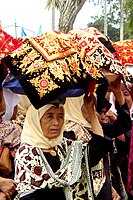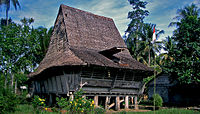geo.wikisort.org - Island
Sumatra[lower-alpha 1] is one of the Sunda Islands of western Indonesia. It is the largest island that is fully within Indonesian territory, as well as the sixth-largest island in the world at 473,481 km2 (182,812 mi.2), not including adjacent islands such as the Simeulue, Nias, Mentawai, Enggano, Riau Islands, Bangka Belitung and Krakatoa archipelago.
 Topography of Sumatra | |
 Location of Sumatra within the Indonesian Archipelago | |
| Geography | |
|---|---|
| Location | Southeast Asia |
| Coordinates | 00°N 102°E |
| Archipelago | Greater Sunda Islands |
| Area | 473,481 km2 (182,812 sq mi) |
| Highest elevation | 3,805 m (12484 ft) |
| Highest point | Kerinci |
| Administration | |
Indonesia | |
| Provinces | Aceh North Sumatra West Sumatra Riau Jambi Bengkulu South Sumatra Lampung |
| Largest settlement | Medan (pop. 2,097,610) |
| Demographics | |
| Population | 59,185,500 (mid 2021 estimate) |
| Pop. density | 125.0/km2 (323.7/sq mi) |
| Ethnic groups | Acehnese, Batak, Gayonese, Lampung, Malay, Mentawai, Minangkabau, Nias, Palembang, Rejang, Chinese, Indian, Javanese etc. |
| Additional information | |
| Time zone |
|
Sumatra is an elongated landmass spanning a diagonal northwest–southeast axis. The Indian Ocean borders the northwest, west, and southwest coasts of Sumatra, with the island chain of Simeulue, Nias, Mentawai, and Enggano off the western coast. In the northeast, the narrow Strait of Malacca separates the island from the Malay Peninsula, which is an extension of the Eurasian continent. In the southeast, the narrow Sunda Strait, containing the Krakatoa Archipelago, separates Sumatra from Java. The northern tip of Sumatra is near the Andaman Islands, while off the southeastern coast lie the islands of Bangka and Belitung, Karimata Strait and the Java Sea. The Bukit Barisan mountains, which contain several active volcanoes, form the backbone of the island, while the northeastern area contains large plains and lowlands with swamps, mangrove forest and complex river systems. The equator crosses the island at its centre in West Sumatra and Riau provinces. The climate of the island is tropical, hot, and humid. Lush tropical rain forest once dominated the landscape.
Sumatra has a wide range of plant and animal species but has lost almost 50% of its tropical rainforest in the last 35 years.[clarification needed] Many species are now critically endangered, such as the Sumatran ground cuckoo, the Sumatran tiger, the Sumatran elephant, the Sumatran rhinoceros, and the Sumatran orangutan. Deforestation on the island has also resulted in serious seasonal smoke haze over neighbouring countries, such as the 2013 Southeast Asian haze which caused considerable tensions between Indonesia and affected countries Malaysia and Singapore.[2]
Etymology
Sumatra was known in ancient times by the Sanskrit names of Suwarnadwīpa ('Island of Gold') and Suwarnabhūmi ('Land of Gold'), because of the gold deposits in the island's highlands.[3] The earliest known mention of the current form "Sumatra" was in 1017, when the local king Haji Sumatrabhumi ("king of the land of Sumatra")[4] sent an envoy to China. Arab geographers referred to the island as Lamri (Lamuri, Lambri or Ramni) in the tenth through thirteenth centuries, in reference to a kingdom near modern-day Banda Aceh which was the first landfall for traders. The island has also been known by other names, including Andalas[5] or Percha Island.[6]
In the late 13th century, Marco Polo referred to the kingdom as Samara, while his contemporary fellow Italian traveller Odoric of Pordenone used the form Sumoltra. Later in the 14th century the local form "Sumatra" became popular abroad due to the rising power of the kingdom of Samudera Pasai and the subsequent Sultanate of Aceh.[7][8]
From then on, subsequent European writers mostly used Sumatra or similar forms of the name for the entire island.[9][10]
History

By the year 692, the Melayu Kingdom was absorbed by Srivijaya.[11]: 79–80
Srivijaya influence waned in the 11th century year 1025 after being defeated by the Chola Empire in southern India.[12] By the end of the 12th century Srivijaya had been reduced to a small kingdom, and its dominant role in South Sumatra with the last king ratu Sekekhummong.[12] At the same time, the spread of Islam in Indonesia occurred gradually and indirectly, starting from the western regions of Indonesia such as the Sumatra area which became the first place for the spread of Islam in the archipelago then Java to the eastern regions of Indonesia, Sulawesi and Maluku.[13] The island of Sumatra is also an area in the archipelago that received the spread of Islam first compared to other islands or other areas.[13] The island of Sumatra became the first area to receive the spread of Islam because of the position of the island of Sumatra which is close to the Malacca strait.[13] The initial process of Islamization related to trade and also the formation of the kingdom.[13] Islam entered Sumatra through pious Arabs and Indian traders in the 6th and 7th centuries AD.[14] At the beginning and end of the 13th century the formation of the kingdom, the king of the Samudra kingdom had converted to Islam. Marco Polo visited the island in 1292, and his fellow Italian Odoric of Pordenone in 1321.
Moroccan scholar Ibn Battuta visited with the sultan for 15 days, noting the city of Samudra was "a fine, big city with wooden walls and towers", and another two months on his return journey.[15] Samudra was succeeded by the powerful Aceh Sultanate, which survived to the 20th century. With the coming of the Dutch, the many Sumatran princely states gradually fell under their control. Aceh, in the north, was the major obstacle, as the Dutch were involved in the long and costly Aceh War (1873–1903).
The Free Aceh Movement fought against Indonesian government forces in the Aceh Insurgency from 1976 to 2005.[16] Security crackdowns in 2001 and 2002 resulted in several thousand civilian deaths.[17]
The island was heavily impacted by both the 1883 Krakatoa eruption and the 2004 Boxing Day Tsunami.
Demographics
| Year | Pop. | ±% |
|---|---|---|
| 1971 | 20,808,148 | — |
| 1980 | 28,016,160 | +34.6% |
| 1990 | 36,506,703 | +30.3% |
| 1995 | 40,830,334 | +11.8% |
| 2000 | 42,616,164 | +4.4% |
| 2005 | 45,839,041 | +7.6% |
| 2010 | 50,613,947 | +10.4% |
| 2015 | 55,198,752 | +9.1% |
| 2020 | 58,557,211 | +6.1% |
| 2021 | 59,185,500 | +1.1% |
| sources:[18][19] | ||
Sumatra is not particularly densely populated, with 125 people per km2 – about 59,185,500 people in total (according to official estimates as at mid 2021).[20] Because of its size, it is nonetheless the fifth[21] most populous island in the world.
- Minangkabau women carrying platters of food to a ceremony
- Traditional house in Nias North Sumatra
Languages
There are over 52 languages spoken, all of which (except Chinese and Tamil) belong to the Malayo-Polynesian branch of the Austronesian language family. Within Malayo-Polynesian, they are divided into several sub-branches: Chamic (which are represented by Acehnese in which its closest relatives are languages spoken by Ethnic Chams in Cambodia and Vietnam), Malayic (Malay, Minangkabau and other closely related languages), Northwest Sumatra–Barrier Islands (Batak languages, Gayo and others), Lampungic (includes Proper Lampung and Komering) and Bornean (represented by Rejang in which its closest linguistic relatives are Bukar Sadong and Land Dayak spoken in West Kalimantan and Sarawak (Malaysia)). Northwest Sumatra–Barrier Islands and Lampungic branches are endemic to the island. Like all parts of Indonesia, Indonesian (which was based on Riau Malay) is the official language and the main lingua franca. Although Sumatra has its own local lingua franca, variants of Malay like Medan Malay and Palembang Malay[22] are popular in North and South Sumatra, especially in urban areas. Minangkabau (Padang dialect)[23] is popular in West Sumatra, some parts of North Sumatra, Bengkulu, Jambi and Riau (especially in Pekanbaru and areas bordered with West Sumatra) while Acehnese is also used as an inter-ethnic means of communication in some parts of Aceh province.
Religion
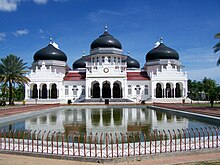
Religion in Sumatra (2022)[24]
The majority of people in Sumatra are Muslims (87.1%), while 10.7% are Christians, and less than 2% are Buddhists and Hindus.[25]
Administration
Sumatra is one of seven geographical regions of Indonesia which includes its adjacent smaller islands. Sumatra was one of the eight original provinces of Indonesia between 1945 and 1948. Including adjacent archipelagoes normally included with Sumatra (such as the Riau Islands, Nias and the Bangka-Belitung group), it now covers ten of Indonesia's 37 provinces, which are set out below with their areas and populations.[26]
| Name | Area (km2) | Population census 2000 | Population census 2010 | Population census 2015 | Population census 2020 | Population estimate 2021 | Capital |
|---|---|---|---|---|---|---|---|
| 57,956.00 | 4,073,006 | 4,486,570 | 4,993,385 | 5,274,871 | 5,333,700 | Banda Aceh | |
(Sumatra Utara) | 72,981.23 | 11,642,488 | 12,326,678 | 13,923,262 | 14,799,361 | 14,936,200 | Medan |
(Sumatra Barat) | 42,012.89 | 4,248,515 | 4,846,909 | 5,190,577 | 5,534,472 | 5,580,200 | Padang |
| 87,023.66 | 3,907,763 | 5,543,031 | 6,330,941 | 6,394,097 | 6,493,600 | Pekanbaru | |
(Kepulauan Riau) | 8,256.10 | 1,040,207 | 1,685,698 | 1,968,313 | 2,064,564 | 2,118,200 | Tanjung Pinang |
| 50,058.16 | 2,407,166 | 3,088,618 | 3,397,164 | 3,548,228 | 3,585,100 | Jambi | |
(Sumatra Selatan) | 91,592.43 | 6,210,800 | 7,446,401 | 8,043,042 | 8,467,432 | 8,550,900 | Palembang |
| 19,919.33 | 1,455,500 | 1,713,393 | 1,872,136 | 2,010,670 | 2,032,900 | Bengkulu | |
| 34,623.80 | 6,730,751 | 7,596,115 | 8,109,601 | 9,007,848 | 9,081,800 | Bandar Lampung | |
(Kepulauan Bangka Belitung) | 16,424.14 | 899,968 | 1,223,048 | 1,370,331 | 1,455,678 | 1,473,200 | Pangkal Pinang |
| Totals | 480,847.74 | 42,616,164 | 50,613,947 | 55,198,752 | 58,557,211 | 59,185,500 |
Geography
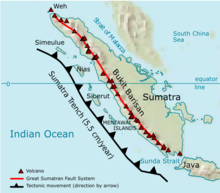

The longest axis of the island runs approximately 1,790 km (1,110 mi) northwest–southeast, crossing the equator near the centre. At its widest point, the island spans 435 km (270 mi). The interior of the island is dominated by two geographical regions: the Barisan Mountains in the west and swampy plains in the east. Sumatra is the closest Indonesian island to mainland Asia.
To the southeast is Java, separated by the Sunda Strait. To the north is the Malay Peninsula (located on the Asian mainland), separated by the Strait of Malacca. To the east is Borneo, across the Karimata Strait. West of the island is the Indian Ocean.
The Great Sumatran fault (a strike-slip fault), and the Sunda megathrust (a subduction zone), run the entire length of the island along its west coast. On 26 December 2004, the western coast and islands of Sumatra, particularly Aceh province, were struck by a tsunami following the Indian Ocean earthquake. This was the longest earthquake recorded, lasting between 500 and 600 seconds.[27] More than 170,000 Indonesians were killed, primarily in Aceh. Other recent earthquakes to strike Sumatra include the 2005 Nias–Simeulue earthquake and the 2010 Mentawai earthquake and tsunami.
Lake Toba is the site of a supervolcanic eruption that occurred around 74,000 years ago, representing a climate-changing event.[28]
The most important rivers in Sumatra belong to the catchment area of the South China Sea. Heading north to south, the Rokan, Siak, Kampar, Indragiri, Batanghari flow into the Malacca Strait, while the island's largest river, the Musi, flows into the sea at Bangka Strait in the south.
To the east, big rivers carry silt from the mountains, forming the vast lowland interspersed by swamps. Even if mostly unsuitable for farming, the area is currently of great economic importance for Indonesia. It produces oil from both above and below the soil – palm oil and petroleum.
Sumatra is the largest producer of Indonesian coffee. Small-holders grow Arabica coffee (Coffea arabica) in the highlands, while Robusta (Coffea canephora) is found in the lowlands. Arabica coffee from the regions of Gayo, Lintong and Sidikilang is typically processed using the Giling Basah (wet hulling) technique, which gives it a heavy body and low acidity.[29]
Sumatra is a highly seismic island, huge earthquakes have been recorded throughout history, in 1797 an 8.9 earthquake shook Western Sumatra, in 1833 a 9.2 earthquake shook Bengkulu and Western Sumatra both events caused large tsunamis. They are very common throughout the coastal area of the west and center of the island, tsunamis are common due to the high seismicity in the area. [citation needed]
Largest cities

By population, Medan is the largest city in Sumatra.[30] Medan is also the most visited and developed city in Sumatra.
| Rank | City | Province | City Birthday | Area (in km2) |
Population 2010 census |
Population 2020 census |
|---|---|---|---|---|---|---|
| 1 | Medan | North Sumatra | 1 July 1590 | 265.10 | 2,097,610 | 2,435,252 |
| 2 | Palembang | South Sumatra | 17 June 1683 | 374.03 | 1,455,284 | 1,668,848 |
| 3 | Bandar Lampung | Lampung | 17 June 1682 | 169.21 | 881,801 | 1,166,066 |
| 4 | Pekanbaru | Riau | 23 June 1784 | 633.01 | 897,767 | 983,356 |
| 5 | Padang | West Sumatra | 7 August 1669 | 694.96 | 833,562 | 909,040 |
| 6 | Jambi | Jambi | 17 May 1946 | 205.00 | 531,857 | 606,200 |
| 7 | Bengkulu | Bengkulu | 18 March 1719 | 144.52 | 308,544 | 373,591 |
| 8 | Dumai | Riau | 20 April 1999 | 2,039.35 | 253,803 | 316,782 |
| 9 | Binjai | North Sumatra | 90.24 | 246,154 | 291,842 | |
| 10 | Pematang Siantar | North Sumatra | 24 April 1871 | 60.52 | 234,698 | 268,254 |
| 11 | Banda Aceh | Aceh | 22 April 1205 | 61.36 | 223,446 | 252,899 |
| 12 | Lubuklinggau | South Sumatra | 17 August 2001 | 419.80 | 201,308 | 234,166 |
Flora and fauna
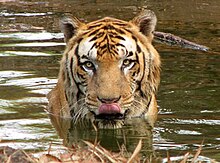

Sumatra supports a wide range of vegetation types that are home to a rich variety of species, including 17 endemic genera of plants.[31] Unique species include the Sumatran pine which dominates the Sumatran tropical pine forests of the higher mountainsides in the north of the island and rainforest plants such as Rafflesia arnoldii (the world's largest individual flower), and the titan arum (the world's largest unbranched inflorescence).
The island is home to 201 mammal species and 580 bird species. There are nine endemic mammal species on mainland Sumatra and 14 more endemic to the nearby Mentawai Islands.[31] There are about 300 freshwater fish species in Sumatra.[32] There are 93 amphibian species in Sumatra, 21 of which are endemic to Sumatra.[33]
The Sumatran tiger, Sumatran rhinoceros, Sumatran elephant, Sumatran ground cuckoo, Sumatran orangutan and Tapanuli orangutan are all critically endangered, indicating the highest level of threat to their survival. In October 2008, the Indonesian government announced a plan to protect Sumatra's remaining forests.[34]
The island includes more than 10 national parks, including three which are listed as the Tropical Rainforest Heritage of Sumatra World Heritage Site – Gunung Leuser National Park, Kerinci Seblat National Park and Bukit Barisan Selatan National Park. The Berbak National Park is one of three national parks in Indonesia listed as a wetland of international importance under the Ramsar Convention.
Rail transport
Several unconnected railway networks built during Netherlands East Indies exist in Sumatra, such as the ones connecting Banda Aceh-Lhokseumawe-Besitang-Medan-Tebingtinggi-Pematang Siantar-Rantau Prapat in Northern Sumatra (the Banda Aceh-Besitang section was closed in 1971, but is currently being rebuilt).[35] Padang-Solok-Bukittinggi in West Sumatra, and Bandar Lampung-Palembang-Lahat-Lubuk Linggau in Southern Sumatra.
See also
- Architecture of Sumatra
- Bukit Seguntang
- Communism in Sumatra
- Music of Sumatra
References
- The Kamus Besar Bahasa Indonesia states that Sumatra is the correct spelling in Indonesian;[1] however, it is popularly spelled in Indonesian as Sumatera.
- "Hasil Pencarian – KBBI Daring" [Entry for "Sumatra" in the online version of the Kamus Besar Bahasa Indonesia]. kbbi.kemdikbud.go.id (in Indonesian). Ministry of Education, Culture, Research, and Technology.
- Shadbolt, Peter (21 June 2013). "Singapore Chokes on Haze as Sumatran Forest Fires Rage". CNN. Archived from the original on 7 November 2017. Retrieved 7 May 2017.
- Drakard, Jane (1999). A Kingdom of Words: Language and Power in Sumatra. Oxford University Press. ISBN 983-56-0035-X.
- Munoz, Paul Michel (2006). Early Kingdoms of the Indonesian Archipelago and the Malay Peninsula. Continental Sales, Incorporated. ISBN 978-981-4155-67-0.
- Marsden, William (1783). The History of Sumatra. Dutch: Longman. p. 5.
- Cribb, Robert (2013). Historical Atlas of Indonesia. Routledge. p. 249.
- Sneddon, James N. (2003). The Indonesian language: its history and role in modern society. UNSW Press. p. 65. ISBN 9780868405988. Archived from the original on 29 May 2016. Retrieved 16 December 2015.
- Macdonell, Arthur Anthony (1924). A Practical Sanskrit Dictionary with Transliteration, Accentuation, and Etymological Analysis. Motilal Banarsidass Publications. p. 347. ISBN 9788120820005. Archived from the original on 6 May 2016. Retrieved 16 December 2015.
- Sir Henry Yule, ed. (1866). Cathay and the Way Thither: Being a Collection of Medieval Notices of China, Issue 36. pp. 86–87. Archived from the original on 21 February 2017. Retrieved 21 February 2017.
- Marsden, William (1811). The History of Sumatra: Containing an Account of the Government, Laws, Customs and Manners of the Native Inhabitants, with a Description of the Natural Productions, and a Relation of the Ancient Political State of That Island. pp. 4–10. Archived from the original on 22 February 2017. Retrieved 21 February 2017.
- Coedès, George (1968). Vella, Walter F. (ed.). The Indianized States of Southeast Asia. Translated by Cowing, Susan Brown. University of Hawaii Press. ISBN 978-0-8248-0368-1.
- https://www.britannica.com/place/Srivijaya-empire
- "Sejarah Masuknya Islam Ke Indonesia". 4 November 2021.
- G.R. Tibbets,Pre-Islamic Arabia and South East Asia, in D.S. Richards (ed.),1970, Islam and The Trade of Asia, Oxford: Bruno Cassirer Pub. Ltd, p. 127 nt. 21; S.Q.Fatimi, In Quest of Kalah, in D.S. Richards (ed.),1970, p.132 n.124; W.P. Groeneveldt, Notes in The Malay Archipelago, in D.S. Richards (ed.),1970, p.129 n.42
- Battutah, Ibn (2002). The Travels of Ibn Battutah. London: Picador. pp. 256, 274, 322. ISBN 9780330418799.
- "Indonesia Agrees Aceh Peace Deal". BBC News. 17 July 2005. Archived from the original on 9 March 2008. Retrieved 17 May 2015.
- "Aceh Under Martial Law: Inside the Secret War: Human Rights and Humanitarian Law Violations". Human Rights Watch. Archived from the original on 6 March 2016. Retrieved 17 May 2015.
- "Penduduk Indonesia menurut Provinsi 1971, 1980, 1990, 1995, 2000 - 2022" [Indonesian Population by Provinces 1971, 1980, 1990, 1995, 2000 and 2010]. Badan Pusat Statistik (in Indonesian). Archived from the original on 1 July 2013. Retrieved 17 July 2013.
- Badan Pusat Statistik, Jakarta, 2022.
- Badan Pusat Statistik, Jakarta, 2021.
- "Population Statistics". GeoHive. Archived from the original on 3 April 2012. Retrieved 25 July 2012.
- Wurm, Stephen A.; Mühlhäusler, Peter; Tryon, Darrell T., eds. (1996). Atlas of Languages of Intercultural Communication in the Pacific, Asia, and the Americas: Vol. I: Maps. Vol II: Texts. Berlin and New York: Mouton de Gruyter. ISBN 9783110819724 – via Google Books.
- "Minangkabau Language". gcanthminangkabau.wikispaces.com. Archived from the original on 4 April 2014.
- https://gis.dukcapil.kemendagri.go.id/peta/
- Badan Pusat Statistik, Kewarganegaraan, Suku Bangsa, Agama, dan Bahasa Sehari-hari Penduduk Indonesia [Citizenship, Ethnicity, Religion, and the Everyday Languages of Indonesian Citizens] (PDF) (in Indonesian), Badan Pusat Statistik, ISBN 978-979-064-417-5, archived (PDF) from the original on 23 September 2015, retrieved 5 January 2019
- Badan Pusat Statistik, Jakartya, 2022.
- Glenday, Craig (2013). Guinness Book of World Records 2014. The Jim Pattison Group. pp. 015. ISBN 978-1-908843-15-9.
- Vogel, Gretchen, How ancient humans survived global ‘volcanic winter’ from massive eruption, Science, 12 March 2018
- "Daerah Produsen Kopi Arabika di Indonesia" [Regional Arabica Coffee Producers in Indonesia]. Kopi Distributor 1995. 28 February 2015. Archived from the original on 2 April 2015. Retrieved 28 February 2015.
- Biro Pusat Statistik, Jakarta.
- Whitten, Tony (1999). The Ecology of Sumatra. Tuttle Publishing. ISBN 962-593-074-4.
- Nguyen, T. T. T., and S. S. De Silva (2006). "Freshwater finfish biodiversity and conservation: an asian perspective". Biodiversity & Conservation 15(11): 3543–3568
- "Hellen Kurniati". The Rufford Foundation. Archived from the original on 25 August 2017. Retrieved 25 August 2017.
- "Forest, Wildlife Protection Pledged at World Conservation Congress". Environment News Service. 14 October 2008. Archived from the original on 3 June 2012. Retrieved 25 July 2012.
- Younger, Scott (6 November 2011). "The Slow Train". Jakarta Globe. Archived from the original on 21 July 2015. Retrieved 19 July 2015.
Further reading
- Grover, Samantha; Sukamta, Linda; Edis, Robert (August 2017). "People, Palm Oil, Pulp and Planet: Four Perspectives on Indonesia's Fire-stricken Peatlands". The Conversation.
- William Marsden, The History of Sumatra, (1783); 3rd ed. (1811) freely available online.
External links
- . Encyclopædia Britannica (11th ed.). 1911.
На других языках
[de] Sumatra
Die Insel Sumatra (gesprochen Sumátra oder Súmatra) oder Sumatera (veraltete indonesische Schreibweise), gehört zu Indonesien und ist mit 473.481 km² die sechstgrößte Insel der Welt. In diese Fläche sind die vorgelagerten Inseln mit zusammen 50.000 km² eingerechnet.- [en] Sumatra
[es] Sumatra
Sumatra (en indonesio, Sumatera) es una gran isla del Sureste asiático localizada en aguas del océano Índico y perteneciente a Indonesia. Con una superficie de 473 605 km², es la sexta isla más grande del mundo y la mayor isla de Indonesia.[nota 1][fr] Sumatra
Sumatra est une île de l'Ouest indonésien située sur l'équateur. Son nom vient de Samudra, la capitale du sultanat de Pasai dans le nord de l'île (en langue malaise, samudera signifie « océan »). Avec ses 473 481 km2, elle a la septième superficie du monde, tout en étant légèrement supérieure à la Papouasie-Nouvelle-Guinée et à la Suède. Le dernier recensement comptait 50 365 538 habitants.[it] Sumatra
Sumatra (AFI: /suˈmatra/[1]; in indonesiano Sumatera[2]) è la sesta isola più estesa del pianeta, con una superficie di circa 470.000 km² ed è la terza isola più grande dell'arcipelago Indonesiano dopo Nuova Guinea e Borneo.[ru] Суматра
Сума́тра[1] (индон. Sumatra, малайск. Sumatera, ачех. Ruja, Sumatra) — остров в западной части Малайского архипелага, в группе Больших Зондских островов. Входит в состав Индонезии. Является шестым по величине островом в мире, вторым по площади среди островов Индийского океана и крупнейшим среди островов, полностью принадлежащих Индонезии. Население по состоянию на 2020 составляет 58,6 млн человек — 21,68 % населения Индонезии[2].Другой контент может иметь иную лицензию. Перед использованием материалов сайта WikiSort.org внимательно изучите правила лицензирования конкретных элементов наполнения сайта.
WikiSort.org - проект по пересортировке и дополнению контента Википедии
